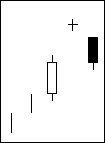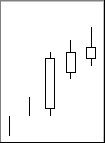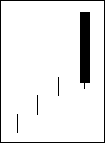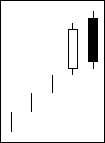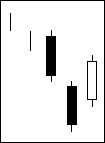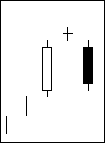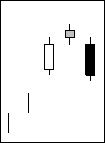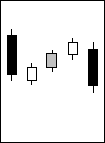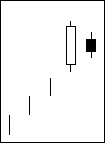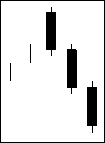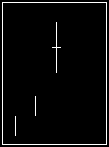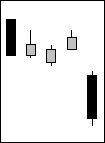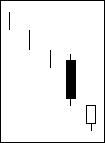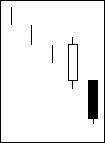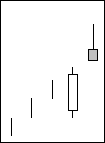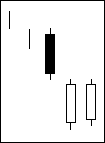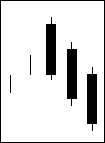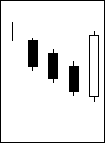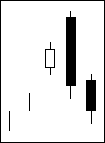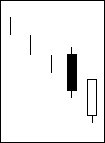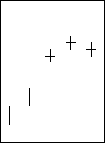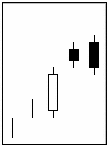Bearish Candle Patterns To Learn
Abandoned Baby Bearish
Like most of the three day star patterns, the scenarios are similar. The primary difference is that the star (second day) can reflect greater deterioration in the prior trend, depending on whether it gaps, is Doji, and so on.
Advance Block Bearish
The Advance Block pattern is a derivative of the Three White Soldiers. However, it must occur in an uptrend, whereas the Three White Soldiers pattern must occur in a downtrend. Unlike the Three White Soldiers, the second and third days of the Advance Block show weakness.
Belt Hold Bearish
The market is trending when a significant gap in the direction of trend occurs on the open. From that point, the market never looks back: all further price action that day is the opposite of the previous trend. This causes much concern and many positions will be covered or sold, which will help accentuate the reversal.
Breakaway
It is important to realize what is being accomplished here. The trend has accelerated with a big gap and then starts to fizzle, but it still moves in the same direction. The slow deterioration of the trend is quite evident from this pattern. Finally, a burst in the opposite direction completely recovers the previous three days' price action. What causes the reversal implication is that the gap has not been filled. A short-term reversal has taken place.
Dark Cloud Cover Bearish
The market is an uptrend. Typical in an uptrend, a long white candlestick is formed. The next day the market gaps higher on the opening, however, that is all that is remaining to the uptrend. The day after, the market drops to close well into the body of the white day, in fact, below its midpoint. Anyone who was bullish would certainly have to rethink their strategy with this type of action. Like the Piercing Line, a significant reversal of trend has occurred.
Deliberation Bearish
This pattern exhibits a weakness similar to the Advance Block pattern in that it gets weak in a short period of time. The difference is that the weakness occurs all at once on the third day. The Deliberation pattern occurs after a sustained upward move and shows that trends cannot last forever. As with the Advance Block, defining the deterioration of the trend can be difficult.
Downside Gap Three Methods Bearish
The market is moving strongly downward. This move is extended further by another day that gaps even more in the direction of the trend. The third day opens well into the body of the second day, then completely fills the gap. This gap-closing move should be looked upon as supporting for the current uptrend. Gaps normally provide excellent support and/or resistance points when considered after a reasonable period of time. Because this gap is filled within one day, some other considerations should be made. If this is the first gap of a move, then the reaction (third day) can be considered as profit taking.
Downside Tasuki Gap Bearing
The psychology behind a Tasuki Gap is quite simple: Go with the trend of the gap. The correction day (the third day) did not fill the gap and the previous trend should continue. This is looked upon as temporary profit taking. The Japanese widely follow gaps (windows). Therefore, the fact that the gap does not get filled or closed means that the previous trend should continue.
Engulfing Bearish
An uptrend is in place when a small white body day occurs with not much volume. The next day, prices open at new highs and then quickly sell off. The sell-off is sustained by high volume and finally closes below the open of the previous day. Emotionally, the uptrend has been damaged. If the next three days prices remain lower, a major reversal of the uptrend has occurred.
Evening Doji Star Bearish
The psychology behind this pattern is similar to that of the Evening star, except that the Doji Star is more of a shock to the previous trend and, therefore, more significant.
Evening Star Bearish
An uptrend has been in place which is assisted by a long white candlestick. There is little doubt about the uptrend continuing with this type of action. The next day prices gap higher on the open, trade within a small range and close near their open. This small body shows the beginning of indecision. The next day the prices gap lower on the open and then close still lower. A significant reversal of trend has occurred.
Falling Three Methods Bearish
The Falling Three Methods pattern is considered a rest from trading. The psychology behind a move like this is that some doubt creeps in about the ability of the trend to continue. This doubt increases as the small-range reaction days take place. However, once the bears see that a new high cannot be made, the bearishness is resumed and new lows are set quickly.
Hanging Man Bearish
For the Hanging Man, the market is considered bullish because of the uptrend. In order for the hanging man to appear, the price action for the day must trade much lower than where it opened, then rally to close near the high. This is what causes the long lower shadow which shows how the market just might begin a sell-off. If the market opens lower the next day, there would be many participants with long positions that would want to look for an opportunity to sell. Steve Nison claims that a confirmation that the hanging man is bearish might be that the body is black and the next day openslower.
Harami Cross Bearish
The Harami Cross starts out the same as that for the basic Harami pattern. A trend has been in place when, all of a sudden, the market gyrates throughout a day without exceeding the body range of the previous day. What is worse, the market closes at the same price as it opened.
Volume of this a Doji day also dries up, reflecting the complete lack of decision of traders. A significant reversal of trend has occurred.
Harami Bearish
An uptrend is in place and is perpetuated with a long white day and high volume. The next day, prices open lower and stay in a small range throughout the day, closing even lower, but still within the previous day's body. In view of this sudden deterioration of trend, traders should become concerned about the strength of this market, especially if volume is light. It certainly appears that the trend is about to change. Confirmation on the third day would be a lower close.
Identical Three Crows Bearish
This pattern resembles a panic selling that should cause additional downside action. Each day's close sets a benchmark for opening prices the next trading day. There is a total absence of buying power in this pattern.
In Neck Bearish
The scenario is almost identical to the On Neck Line, except that the downtrend may not continue quite as abruptly because of the somewhat higher close.
Long Legged Doji Bearish
The Long Legged Doji has long upper and lower shadows with the open and the close very close or the same. This pattern reflects the indecision of buyers and sellers. The open and the close of the day are very close or are the same. The lower and upper shadows are very long. The high of the day is very high and at the top of the trend.
Low Price Gapping Play Bearish
The Low Price Gapping Play is the bearish counterpart of the High Price Gapping Play, and leads a renewed fall out of a stalled downtrend. The pattern this forms is a downside windowfroma low-price congestion band. After a sharp decline the market consolidates via a series of real small bodies near the recent lows. If prices gap under this consolidation it is asell signal.
Meeting Lines Bearish
There exists an almost opposite relationship for the bearish Meeting Line relative to the Dark Cloud Cover pattern. The bearish Meeting Line opens at a new high and then closes at the same close of the previous day, while the Dark Cloud Cover pattern drops to below the midpoint.
On Neck Bearish
The On Neck Line usually appears during a decline. Bearishness is increased with the long black first day. The market gaps down on the second day, but cannot continue the downtrend. As the market rallies, it is stopped at the previous day's low price. This must be uncomfortable for the bottom fishers who go into the market that day. The downtrend should continue shortly.
Separating Lines Bearish
While the market is in a downtrend, the forming of a long white body should be causeforconcern for the bears, since this shows signs of a possible rally. However, the next day opens much lower, in fact, it opens at the previous white days opening price. Prices then move lower for the rest of the day and close lower, which suggests that the prior downtrend shouldcontinue.
Shooting Star Bearish
During an uptrend, the market gaps open, rallies to a new high, and then closes near its low. This action, following a gap up, can only be considered as bearish. Certainly, it would cause some concern to any bulls who have profits.
Side-By-Side White Lines Bearish
A downtrend is further enhanced with a long black candle line followed by a large downward gap open on the next day. The market trades higher all day, but not high enough to close the gap.
The third day opens lower, at about the same open as the second day. Because of the resistance to further downside action, shorts are covered, causing the third day also to rally and close higher, but again not high enough to close the gap. If enough short covering was accomplished and the rally attempt was not very convincing, the downtrend should continue.
Three Black Crows Bearish
The market is either approaching a top or has been at a high level for some time. A decisive trend move to the downside is made with a long black day. The next two days are accompanied by further erosion in prices caused by much selling and profit taking. This type of price actionhasto take its toll on the bullish mentality.
Three Inside Down Bearish
This pattern, being a confirmation for the Bearish Harami, can only show the success of the forecast. The Bearish Three Inside Down is a confirmation pattern for the Bearish Harami. Its pattern is defined by the first two days of the three day pattern forming a Bearish Harami, and the third day giving support to the suggested reversal of the Harami, by being a black candle closing with a new low for the three days.
Three Line Strike Bearish
The market has continued in its trend, aided by the recent Three Black Crows pattern. The fourth day opens in the direction of the trend, but profit taking or short covering causes the market to move strongly in the opposite direction. This action causes considerable soul searching, but remember that this move completely eradicated the previous three days. This surely dried up the short-term reversal sentiment and the trend should continue in its previous direction.
Three Outside Down Bearish
These patterns, representing the confirmation of the Bearish Engulfing pattern, can only show the success of the forecast.
Thrusting Bearish
Much like the On Neck and In Neck Lines, the Thrusting Line represents a failure to rally in a down market. Because of this failure, the bulls will be discouraged and a lack of buying will let the downtrend continue.
TriStar Bearish
The market has probably been in an uptrend for a long time. With the trend starting to show weakness, bodies probably are becoming smaller. The first Doji would cause considerable concern. The second Doji would indicate that there was no direction left in the market. Finally, the third Doji would put the last nail in the coffin of the trend. This is essentially because this pattern indicates too much indecision, and everyone with any conviction would be reversing positions.
Two Crows Bearish
The market has had an extended up move. A gap higher followed by a lower close for the second day shows that there is some weakness in the rally. The third day opens higher, but not above the open of the previous day, and then sells off. The sell-off closes well into the body of the first day. This action fills the gap after only the second day. The bullishness has to be eroded quickly.
Upside Gap Two Crows Bearish
Like the beginning of most bearish reversal patterns a white body day occurs in an uptrend. The next day opens with a higher gap, fails to rally and closes lower forming a black day. This is not too worrisome because it still did not get lower than the first days close. On the third day prices gap to a higher open and then drop to close lower than the previous days close. This closing price, however, is still above the close of the white first day. The bullishness is bound to subside. How can you have two successively lower closes and still be a raging bull?
